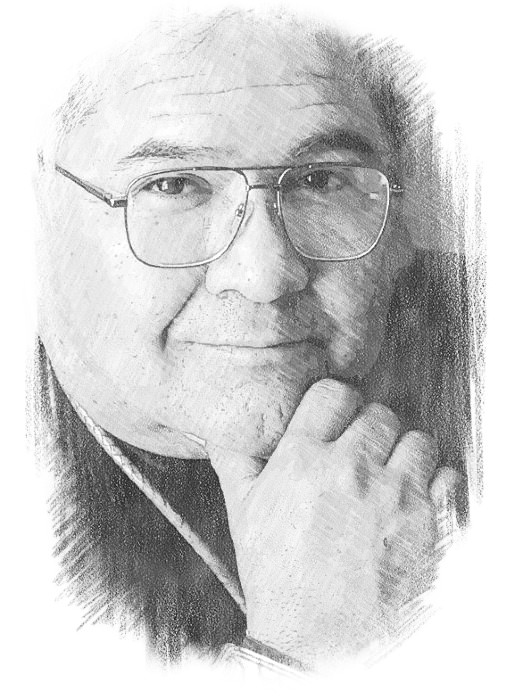
Baje Whitethorne, Sr.
(1951-2023)
Baje grew up on the Navajo Reservation near Shonto, Arizona. As a child, he was first drawn into the world of storytelling when he and his brothers would make up stories on the way to their grandmother’s house. His talent for art was apparent even in grade school, and his teachers were all supportive of his gift.
Currently, Baje resides in Flagstaff, Arizona, and he continues to pursue his childhood interests of storytelling and art. His artwork reflects his homeland and rich culture, depicting striking landscapes and the harmony of the Navajo way of life. In most of his pieces is a small folding chair, popularly regarded as Baje’s personal trademark.
Baje has illustrated eight children’s books, two of which he also authored. Among them are the Native American legends Monster Bird, Monster Slayer, and Sika and the Raven. His unique style has earned him the Western Heritage Wrangler Award from the Cowboy Hall of Fame, in addition to many other honors.
Baje’s artwork can be seen at various museums, art galleries, and private collections across the globe.
Source: Baje Whitethorne
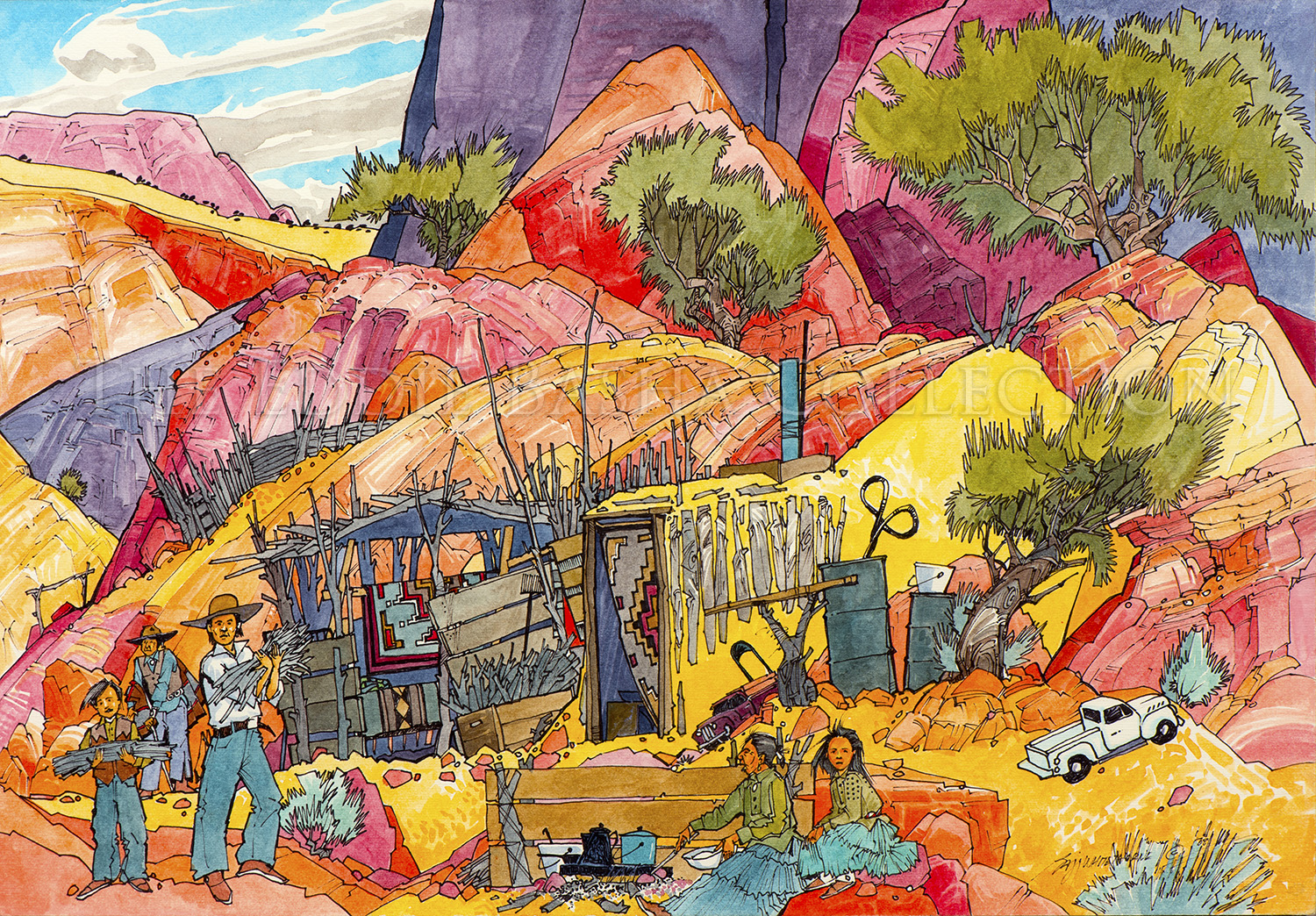
The Small Canyon
Artist: Baje Whitethorne, Sr. (1951-2023)
Description: Watercolor (2008) | Image Size: 14”h x 20”w; Framed Size: 23 ½”h x 32 ½”wpainting
“A professor once suggested I integrate a personal perspective in my work which I gave some thought to” recalled Baje Whitethorne. “Sometime later, the chair and the water drum instinctively appeared in my Navajo life landscape pieces. I remembered when I was young a table and chairs were staples outside our family home. One day, my parents brought home two of the old, blue metal folding type chairs which were placed near the others. As kids my siblings and I didn’t initially appreciate them, but eventually I became very fond of those chairs. And the water drum, it was a staple fixture too since we filled it daily from either the well or stream as our home did not having running water.”
The chair and water drum are iconic images of the Navajo. And when you come across a Baje Whitethorne Navajo Life Landscape art piece, “sit a spell when you find the chair, have a drink of water and let your eyes rest upon the beauty which surrounds you.”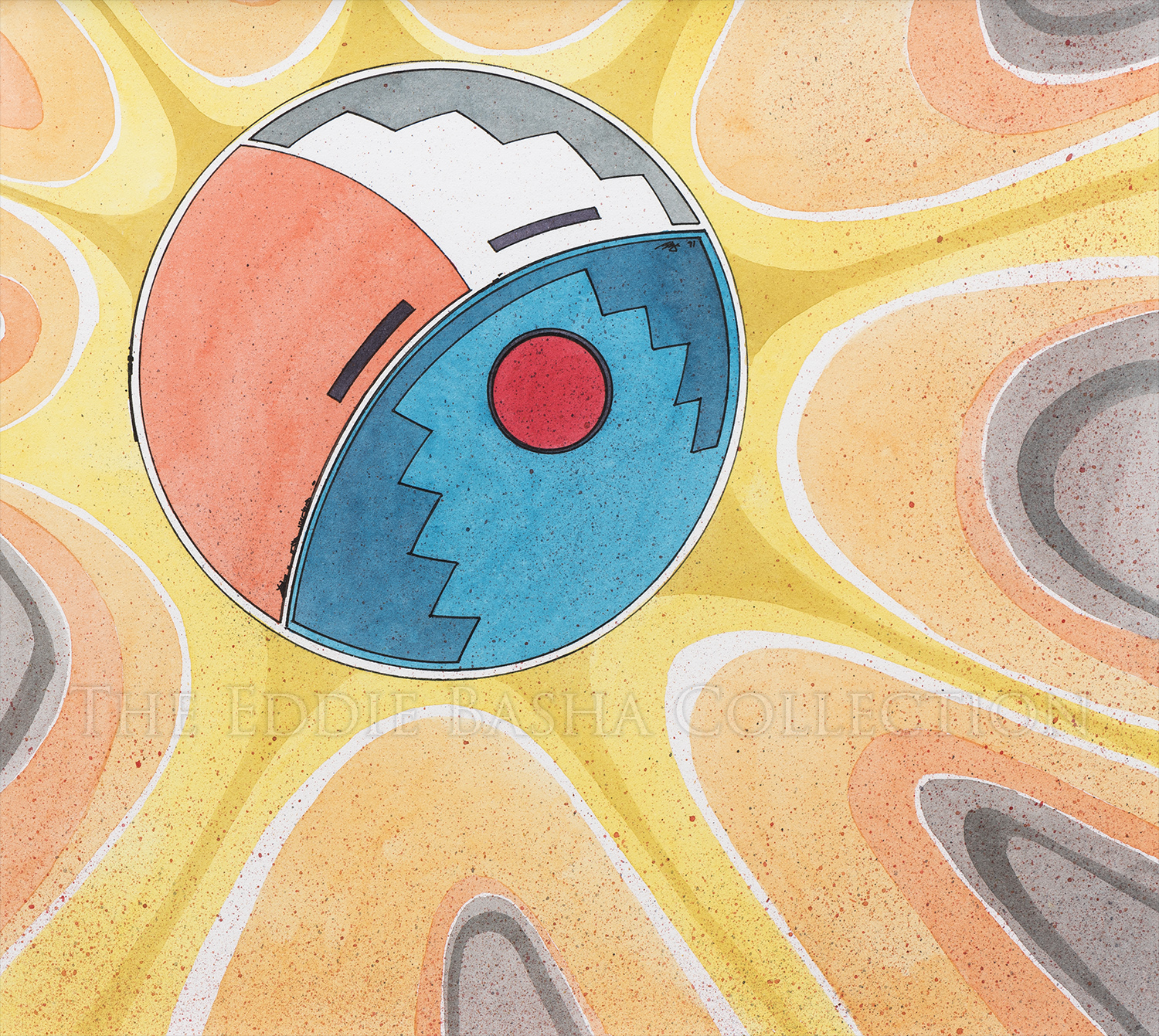
The Sun, Father of the Twins
Artist: Baje Whitethorne, Sr. (1951-2023)
Description: Watercolor & Ink (1991) | Image Size: 13”h x 14”w; Framed Size: 21”h x 25”wpainting
This watercolor was inspired by the first children’s book illustrated by Baje Whitethorne, Sr., “Monster Slayer”. It was the first time Whitethorne viewed the sun as a person which, in turn, made him evolve as a person. He shared, “the Sun has a lot of responsibility; he is the center of the galaxy and the giver of light to make all things grow.”
There is a story in Navajo creation of the Holy Twins, sons of Changing Woman and their father, the Sun. A terrible monster had been plaguing the Anasazi villages of the Southwest's canyon country, so much so that the villagers were afraid to plant their crops. Who will save them from this monster’s wrath? The Twins, 12-year old sons of Changing Woman and the Sun, respond to the villagers' cries for help. And the journey begins for the twins as the tale unfolds.
“Monster Slayer” received the National Cowboy & Western Heritage Museum’s Hall of Fame “Best Juvenile Book" Western Heritage Award in 1999.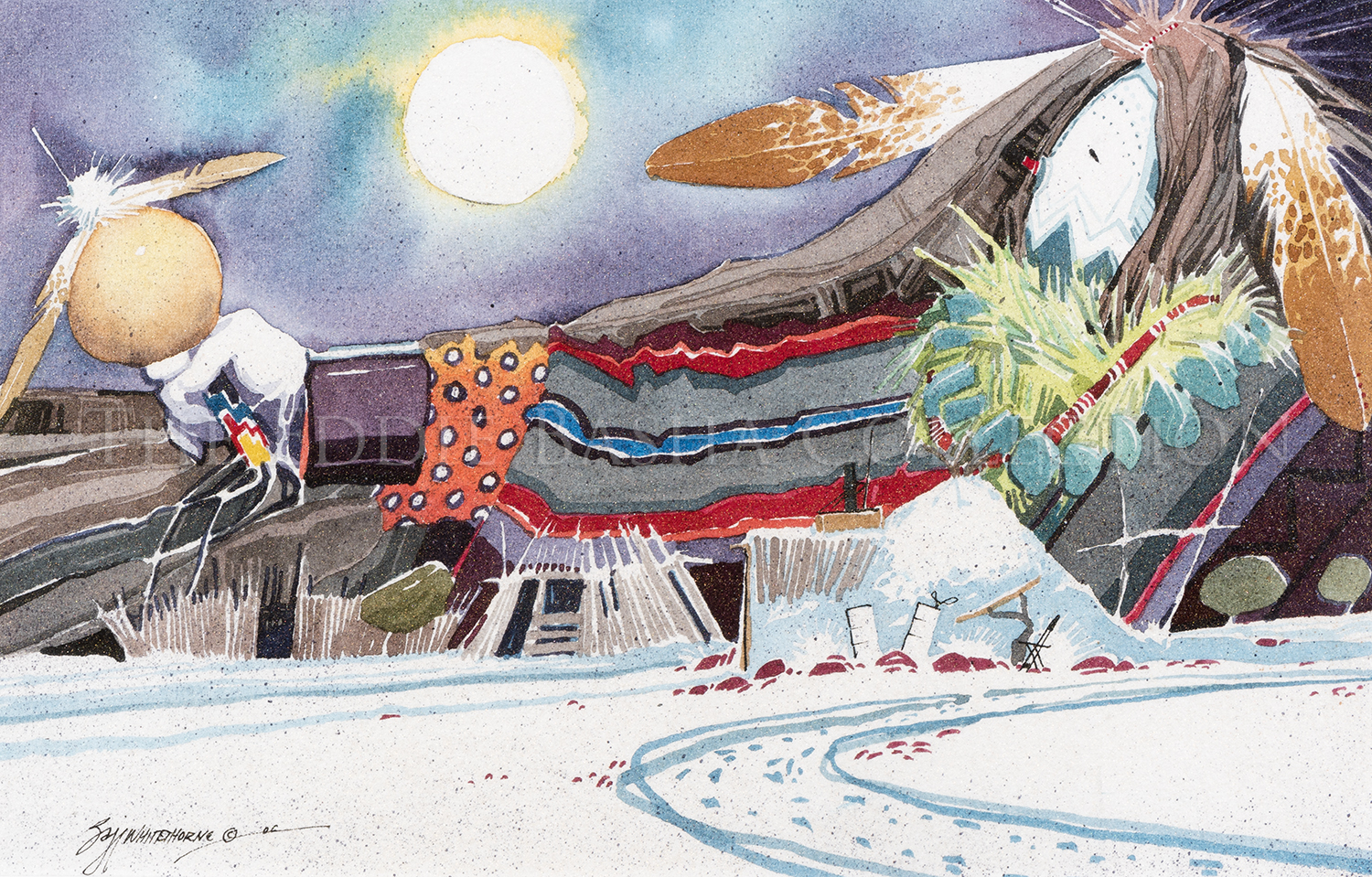
Song of the Yeiˈbeˈchiˈ
Artist: Baje Whitethorne, Sr. (1951-2023)
Description: Watercolor (2006) | Image Size: 7”h x 10”w; Framed Size: 14 ¾”h x 18 ¾”wpainting
During the cold winter months, the nine night Navajo ceremony called Night Chant or Nightway, the masked dancers that personify the gods are identified as Yeiˈbeˈchiˈ. Their songs can be heard throughout each of the evening ceremonies.
Whitethorne has won numerous honors and awards throughout his professional career. He is quick to share his passion for the arts, knowledge and skills with youth across Arizona and at the Art of the People Fine Art Exhibitions sponsored by the Navajo Nation Shopping Centers.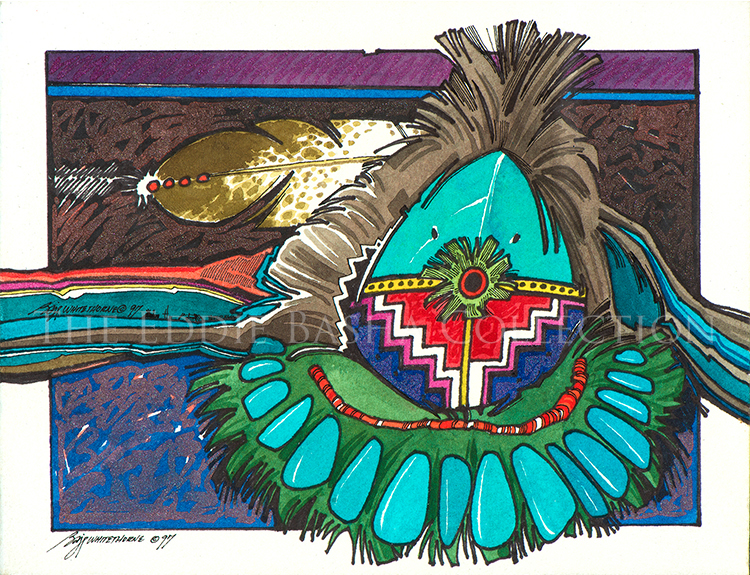
Silent Shadows
Artist: Baje Whitethorne, Sr. (1951-2023)
Description: Watercolor | Image Size: 5 ½”h x 7”w; Framed Size: 14 ¼”h x 16 ¼”wpainting
Baje Whitethorne grew up on the Navajo Reservation near Shonto, Arizona. As a child, he and his siblings would make up stories on their way to visit their grandparents. That storytelling trait remains a constant in his art as are the reflections of his rich culture including Navajo deities such as the one portrayed. Baje has also illustrated numerous children’s books, a few of which he also authored.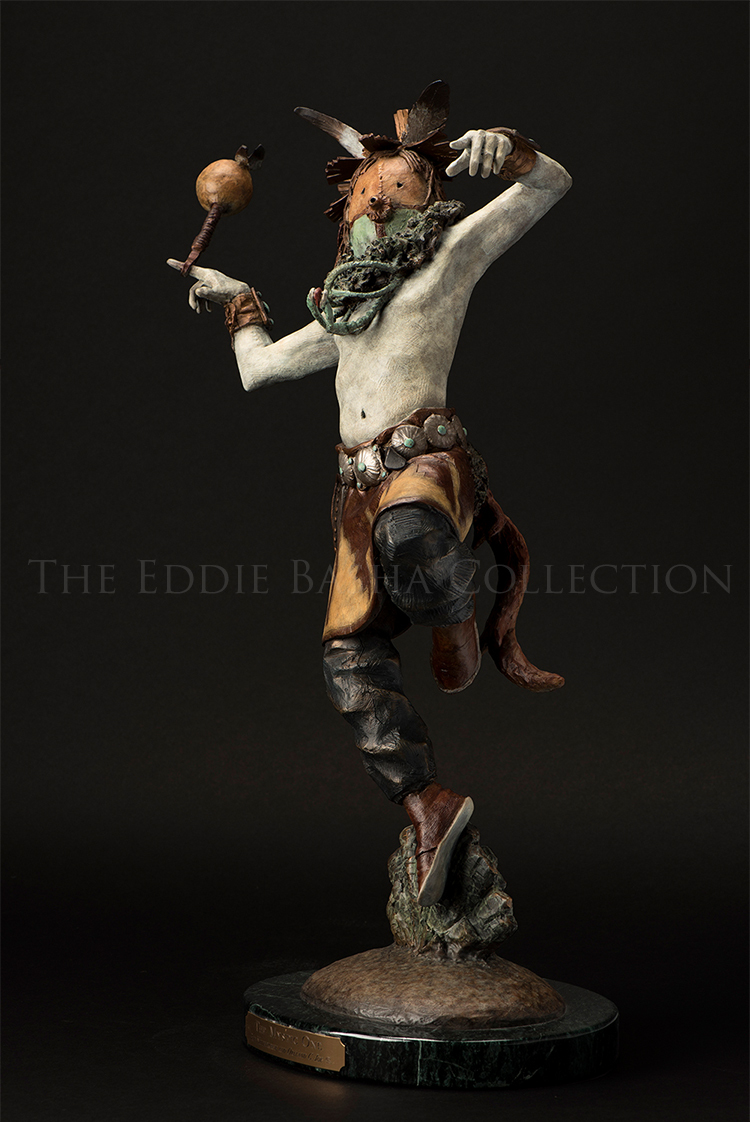
Mystic One
Artist: Baje Whitethorne, Sr. (1951-2023)
Description: Bronze (2002) | Dimensions: 22”h x 11”w x 9”d; Edition #11 of 30bronze
Friends as well as professional artists, Baje Whitethorne and Oreland Joe worked collaboratively on this sculpture. At that time, Baje sought out the technical expertise his friend Oreland could provide. The EBC is of the opinion they worked quite well together!
Both artists work can be found in museums and private collections worldwide.
Sweat Lodge
Artist: Baje Whitethorne, Sr. (1951-2023)
Description: Watercolor (1999) | Image Size: 18”h x 12”w; Framed Size: 28 ¼”h x 21 ¼”painting
“This is a traditional sweat lodge. The doorway is covered with a blanket to seal it and there are boards behind for privacy, blocking out any view within because clothing isn’t worn when inside. A fire is built and the stones gathered next to it are heated and placed inside the lodge. The second stone pile are those that have cooled and been removed from the lodge. The bucket of water next to the lodge is provided so occupants when finished inside can take a drink from the bucket. Grandfathers would spend time with the young boys in the sweat lodge teaching them the lessons and songs that needed to be learned,” shared Baje Whitethorne.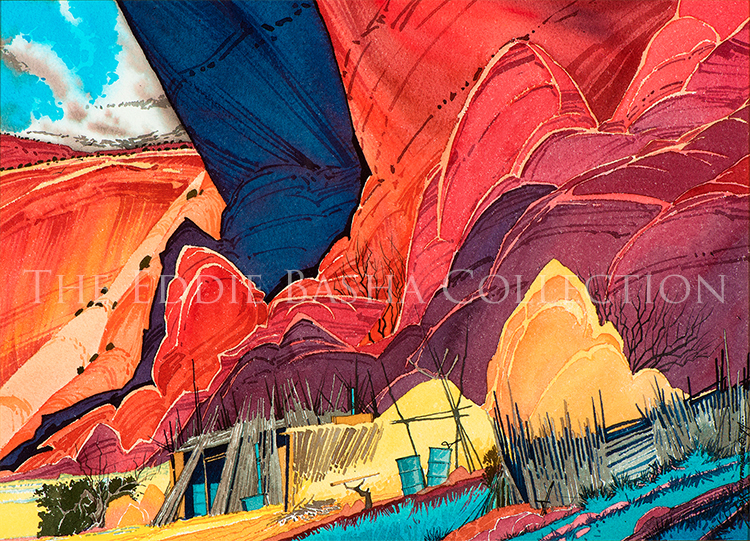
Red Canyon Pass
Artist: Baje Whitethorne, Sr. (1951-2023)
Description: Watercolor (1994) | Image Size: 10”h x 14”w; Framed Size: 19 ½”h x 23 ½”wpainting
Baje Whitethorne Sr. grew up on the Navajo Reservation near Shonto, Arizona. As a child, Baje and his siblings would make up stories on their way to visit their grandparents. That storytelling trait continues in Whitethorne’s art which is a reflection of his rich Diné (Navajo) culture and striking landscapes of the West.
“When I was a boy, my parents and grandparents brought home a new card table with six metallic blue chairs. In the summer months, I would put my face against the cool seat of the chairs. Now, I include the chair in my artwork because it reminds me of my boyhood and because it draws people into the work when they try to find it,” shared Baje.
Baje has illustrated numerous children’s books, two of which he also authored “Sunpainters” and “Father’s Boots.” Baje has received a number of honors for his work including the Western Heritage Wrangler Award from the National Cowboy and Western Heritage Museum in Oklahoma City. His work can be found in numerous collections and museums worldwide.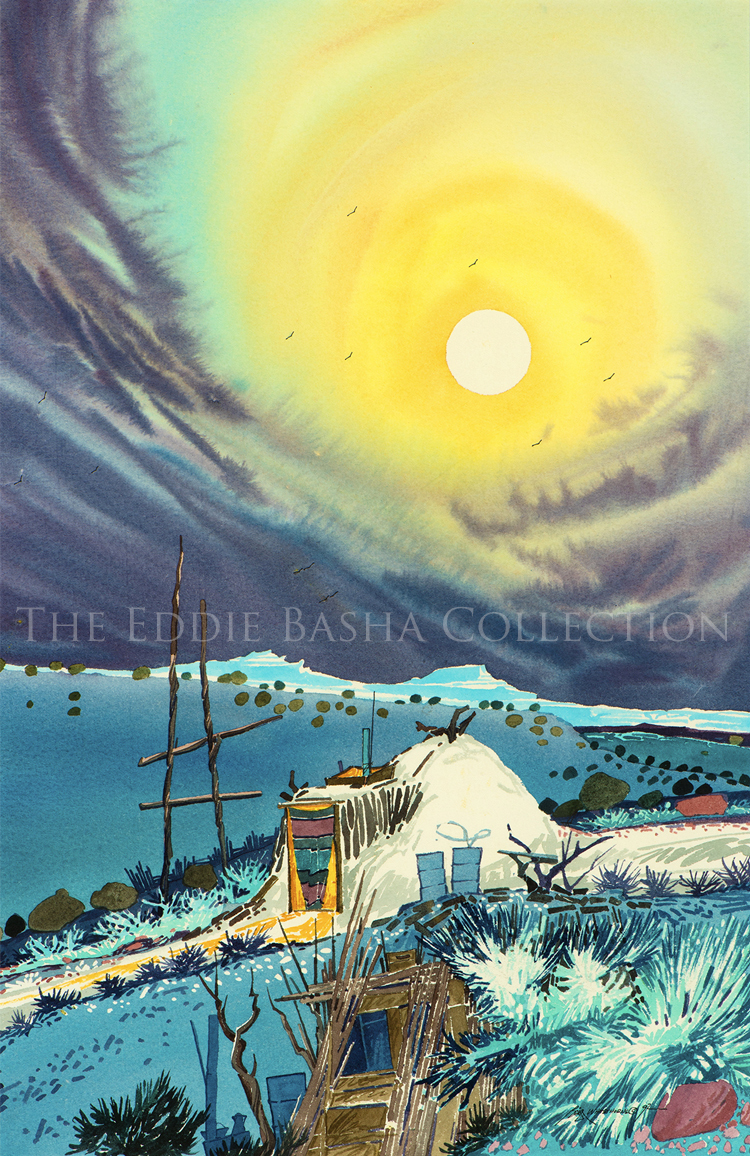
Seasons of the Cold Moon
Artist: Baje Whitethorne, Sr. (1951-2023)
Description: Watercolor (1992) | Image Size: 22”h x 14”w; Framed Size: 33 ½”h X 25 ½”wpainting
Whitethorne Sr, Baje grew up on the Navajo Reservation near Shonto, Arizona. As a child, Baje and his brothers would make up stories on their way to visit their grandmother. That storytelling trait continues in Whitethorne’s art which is a reflection of his rich culture and striking landscapes as seen here in “Seasons of the Cold Moon”.
Baje has illustrated eight children’s books, two of which he also authored. Among them are stories surrounding the Native American legends of Monster Bird, Monster Slayer, and Sika and the Raven. Baje has received a number of honors for his work including the Western Heritage Wrangler Award from the National Cowboy and Western Heritage Museum in Oklahoma City.
In addition, Baje encourages and shares his knowledge and skills with youth across Arizona and frequently at the Art of the People Fine Art Exhibitions sponsored by the Navajo Nation Shopping Centers, Inc. Navajo Nation Museum Native American Heritage Month Flagstaff, Arizona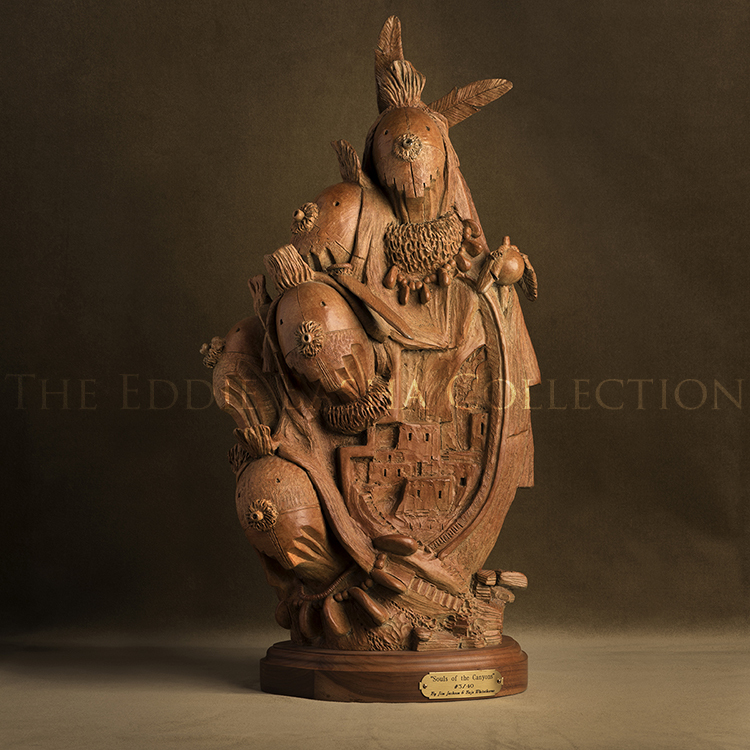
Souls of the Canyons
Artist: Baje Whitethorne, Sr. (1951-2023)
Description: Baje Whitethorne (b.1951) and Jim Jackson (b.1963)bronze
Bronze | Bronze 24”h x 14”w x 11”d; Edition #3 of 40
Collaboratively, Navajo artist Baje Whitethorne Sr and Modoc artist Jim Jackson sculpted “Souls of the Canyons”. It was one of Baje’s early ventures as a sculptor and he was excited to do so alongside his friend and sculpting mentor. Five Yéi, Navajo Holy People who mediate between the Great Spirit and humans, also provide healing powers and protection. Yei are often depicted in sand paintings and in weavings. And, approximately mid-sculpture, a pueblo is seen in the canyon walls.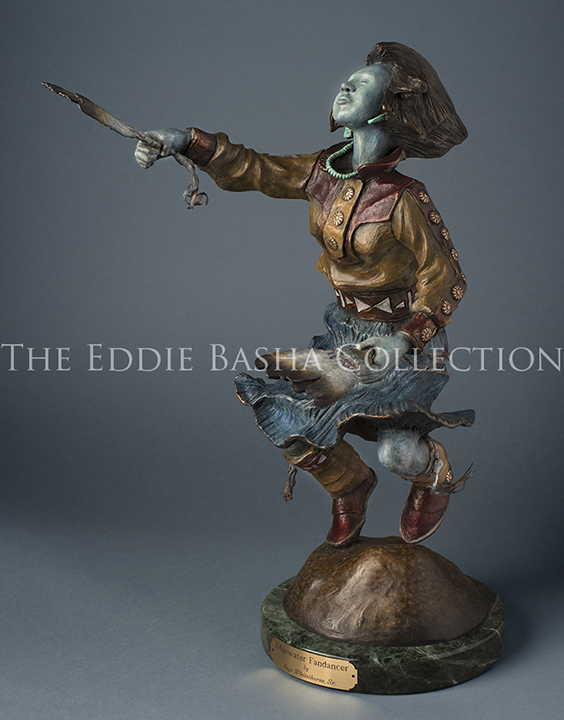
Edgewater Fan Dancer
Artist: Baje Whitethorne, Sr. (1951-2023)
Description: Bronze (2004) | Image Size: 21”h x 11”w x 11”d; Edition #4 of 30bronze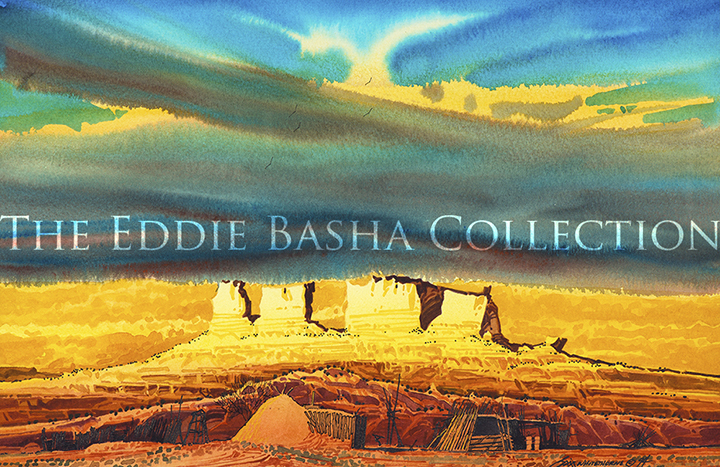
untitled
Artist: Baje Whitethorne, Sr. (1951-2023)
Description: Watercolor (1994) | Image Size: 7 ½”h x 11”w; Framed: 18 ¼”h x 22 ½”wpainting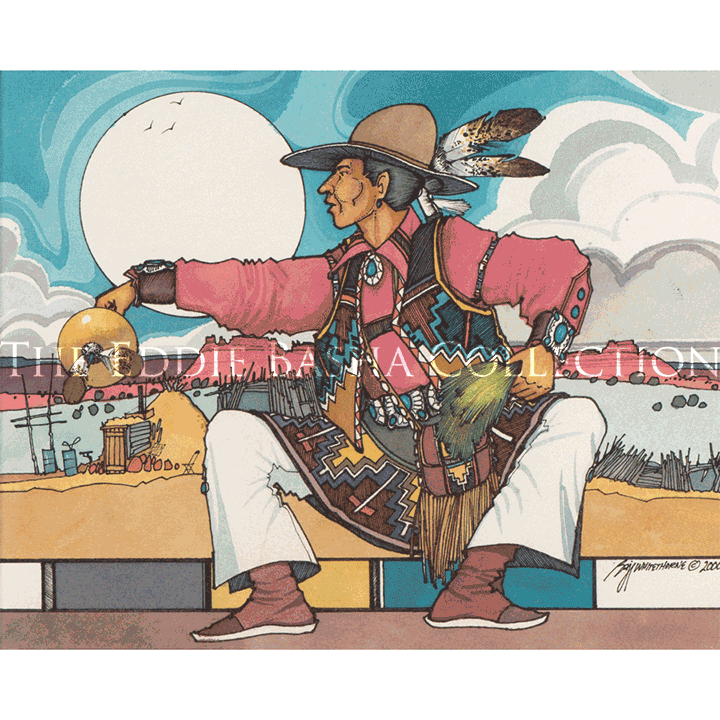
Take A Closer Look – Water Drum & Chair
Artist: Baje Whitethorne, Sr. (1951-2023)
Description: (1951) | Image Size: 9”h x 13”wpainting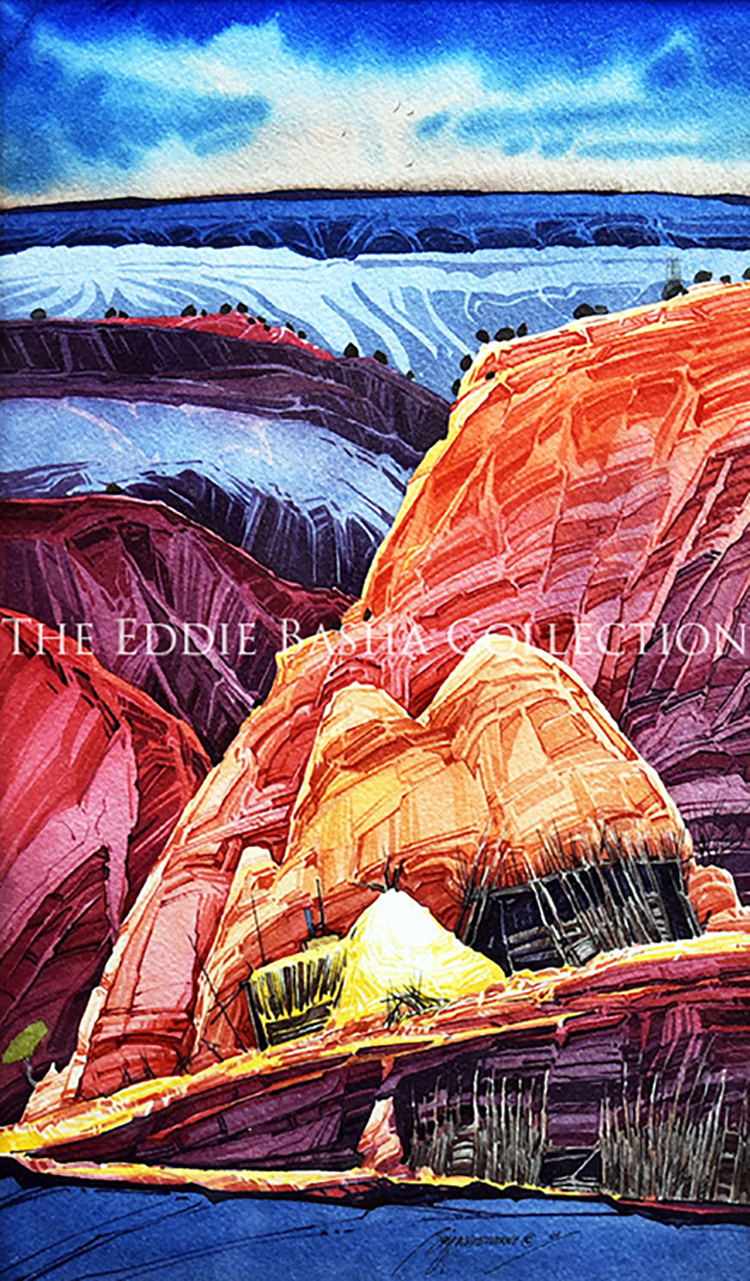
A Morning
Artist: Baje Whitethorne, Sr. (1951-2023)
Description: Watercolor (2001) | Image Size: 18”h x 12”w; Framed Size: 24”h x 18”wpainting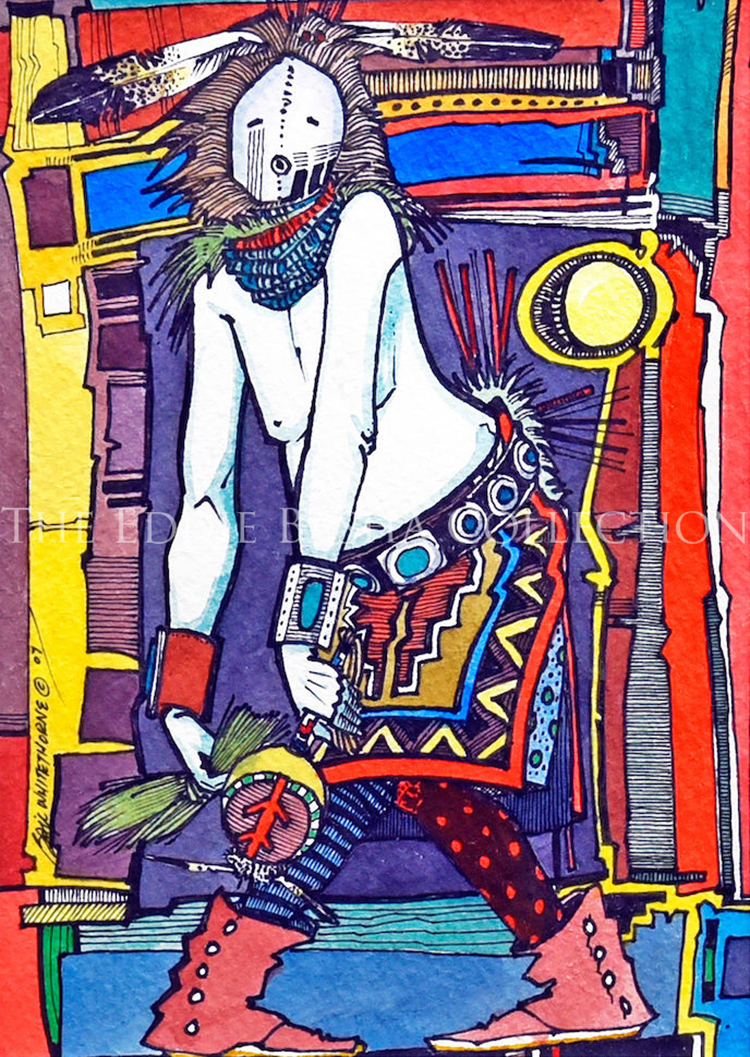
Fancy Pants
Artist: Baje Whitethorne, Sr. (1951-2023)
Description: Watercolor (2007) | Image Size: 7”h x 5”w; Framed Size: 17 ¼”h x 14 ¼”wpainting
Baje Whitethorne’s “Fancy Pants” is but one of the Yei Be Chei dancers that performs during Navajo ceremonials. The dancers are the embodiment of the Yei Spirit who is the mediator between humans and the Great Spirit. There are over 50 types of ceremonials within the Navajo culture which occur at different times but for very detailed reasons. Ceremonies vary in length and occur at different times during the day or night; some only last for a few hours while others are nine days long.
As a child, Whitethorne and his brothers would make up stories on their way to visit their grandparents. That storytelling trait is a mainstay in his art which is a reflection of his treasured Navajo culture and often includes striking landscapes. Baje has illustrated richly and vibrantly several children’s books and authored a few as well. He has received numerous honors for his work throughout his career.
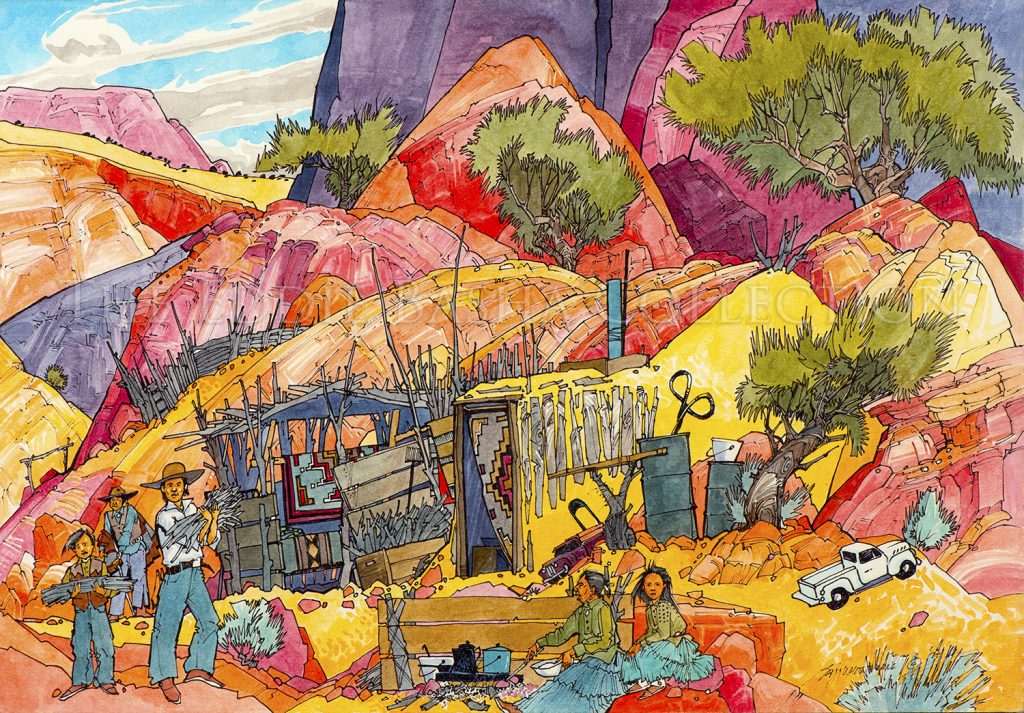 Watercolor (2008) | Image Size: 14”h x 20”w; Framed Size: 23 ½”h x 32 ½”w
Watercolor (2008) | Image Size: 14”h x 20”w; Framed Size: 23 ½”h x 32 ½”w“A professor once suggested I integrate a personal perspective in my work which I gave some thought to” recalled Baje Whitethorne. “Sometime later, the chair and the water drum instinctively appeared in my Navajo life landscape pieces. I remembered when I was young a table and chairs were staples outside our family home. One day, my parents brought home two of the old, blue metal folding type chairs which were placed near the others. As kids my siblings and I didn’t initially appreciate them, but eventually I became very fond of those chairs. And the water drum, it was a staple fixture too since we filled it daily from either the well or stream as our home did not having running water.”
The chair and water drum are iconic images of the Navajo. And when you come across a Baje Whitethorne Navajo Life Landscape art piece, “sit a spell when you find the chair, have a drink of water and let your eyes rest upon the beauty which surrounds you.”
The Small Canyon
Artist: Baje Whitethorne, Sr. (1951-2023)
“A professor once suggested I integrate a personal perspective in my work which I gave some thought to” recalled Baje Whitethorne. “Sometime later, the chair and the water drum instinctively appeared in my Navajo life landscape pieces. I remembered when I was young a table and chairs were staples outside our family home. One day, my parents brought home two of the old, blue metal folding type chairs which were placed near the others. As kids my siblings and I didn’t initially appreciate them, but eventually I became very fond of those chairs. And the water drum, it was a staple fixture too since we filled it daily from either the well or stream as our home did not having running water.”
The chair and water drum are iconic images of the Navajo. And when you come across a Baje Whitethorne Navajo Life Landscape art piece, “sit a spell when you find the chair, have a drink of water and let your eyes rest upon the beauty which surrounds you.”
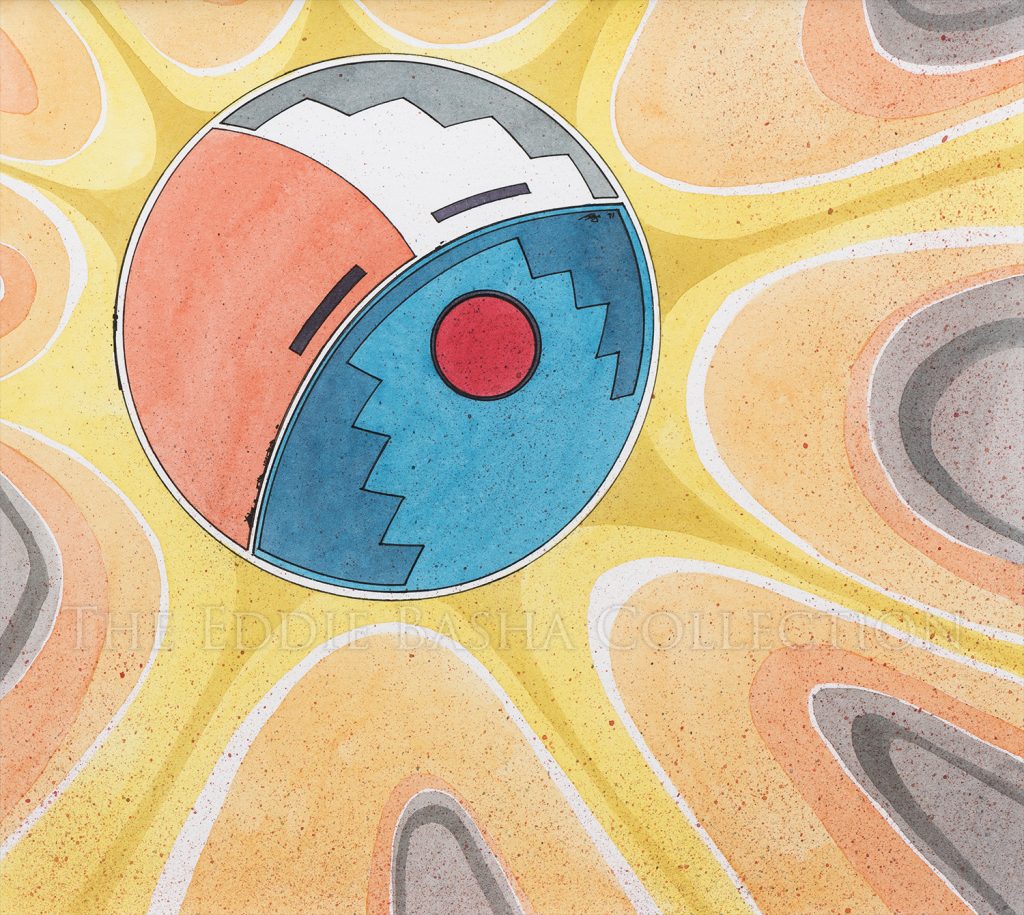 Watercolor & Ink (1991) | Image Size: 13”h x 14”w; Framed Size: 21”h x 25”w
Watercolor & Ink (1991) | Image Size: 13”h x 14”w; Framed Size: 21”h x 25”wThis watercolor was inspired by the first children’s book illustrated by Baje Whitethorne, Sr., “Monster Slayer”. It was the first time Whitethorne viewed the sun as a person which, in turn, made him evolve as a person. He shared, “the Sun has a lot of responsibility; he is the center of the galaxy and the giver of light to make all things grow.”
There is a story in Navajo creation of the Holy Twins, sons of Changing Woman and their father, the Sun. A terrible monster had been plaguing the Anasazi villages of the Southwest's canyon country, so much so that the villagers were afraid to plant their crops. Who will save them from this monster’s wrath? The Twins, 12-year old sons of Changing Woman and the Sun, respond to the villagers' cries for help. And the journey begins for the twins as the tale unfolds.
“Monster Slayer” received the National Cowboy & Western Heritage Museum’s Hall of Fame “Best Juvenile Book" Western Heritage Award in 1999.
The Sun, Father of the Twins
Artist: Baje Whitethorne, Sr. (1951-2023)
This watercolor was inspired by the first children’s book illustrated by Baje Whitethorne, Sr., “Monster Slayer”. It was the first time Whitethorne viewed the sun as a person which, in turn, made him evolve as a person. He shared, “the Sun has a lot of responsibility; he is the center of the galaxy and the giver of light to make all things grow.”
There is a story in Navajo creation of the Holy Twins, sons of Changing Woman and their father, the Sun. A terrible monster had been plaguing the Anasazi villages of the Southwest's canyon country, so much so that the villagers were afraid to plant their crops. Who will save them from this monster’s wrath? The Twins, 12-year old sons of Changing Woman and the Sun, respond to the villagers' cries for help. And the journey begins for the twins as the tale unfolds.
“Monster Slayer” received the National Cowboy & Western Heritage Museum’s Hall of Fame “Best Juvenile Book" Western Heritage Award in 1999.
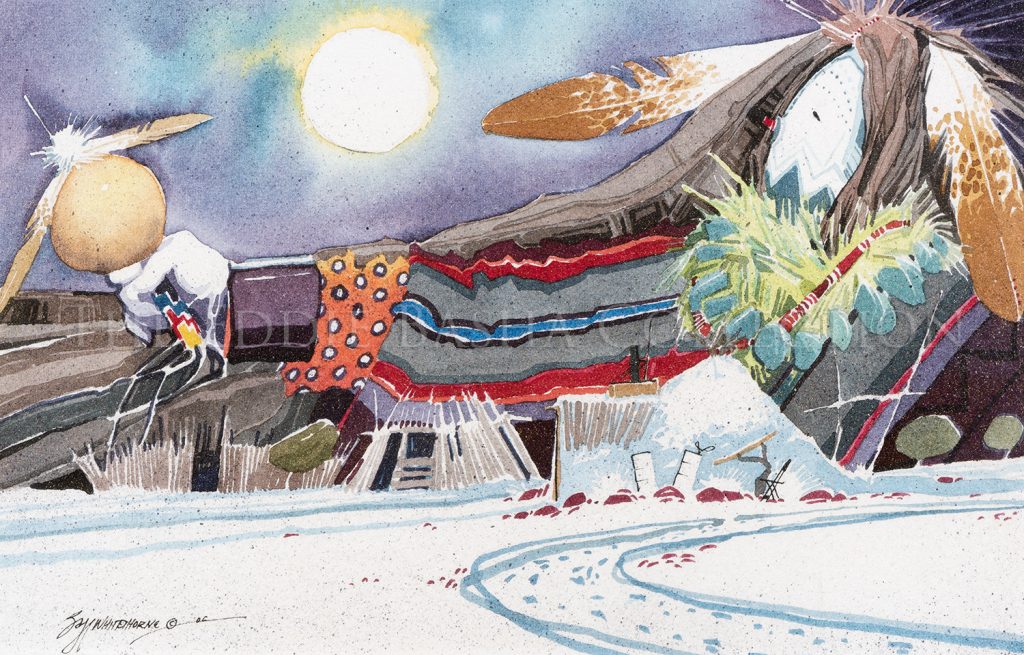 Watercolor (2006) | Image Size: 7”h x 10”w; Framed Size: 14 ¾”h x 18 ¾”w
Watercolor (2006) | Image Size: 7”h x 10”w; Framed Size: 14 ¾”h x 18 ¾”wDuring the cold winter months, the nine night Navajo ceremony called Night Chant or Nightway, the masked dancers that personify the gods are identified as Yeiˈbeˈchiˈ. Their songs can be heard throughout each of the evening ceremonies.
Whitethorne has won numerous honors and awards throughout his professional career. He is quick to share his passion for the arts, knowledge and skills with youth across Arizona and at the Art of the People Fine Art Exhibitions sponsored by the Navajo Nation Shopping Centers.
Song of the Yeiˈbeˈchiˈ
Artist: Baje Whitethorne, Sr. (1951-2023)
During the cold winter months, the nine night Navajo ceremony called Night Chant or Nightway, the masked dancers that personify the gods are identified as Yeiˈbeˈchiˈ. Their songs can be heard throughout each of the evening ceremonies.
Whitethorne has won numerous honors and awards throughout his professional career. He is quick to share his passion for the arts, knowledge and skills with youth across Arizona and at the Art of the People Fine Art Exhibitions sponsored by the Navajo Nation Shopping Centers.
 Watercolor | Image Size: 5 ½”h x 7”w; Framed Size: 14 ¼”h x 16 ¼”w
Watercolor | Image Size: 5 ½”h x 7”w; Framed Size: 14 ¼”h x 16 ¼”wBaje Whitethorne grew up on the Navajo Reservation near Shonto, Arizona. As a child, he and his siblings would make up stories on their way to visit their grandparents. That storytelling trait remains a constant in his art as are the reflections of his rich culture including Navajo deities such as the one portrayed. Baje has also illustrated numerous children’s books, a few of which he also authored.
Silent Shadows
Artist: Baje Whitethorne, Sr. (1951-2023)
Baje Whitethorne grew up on the Navajo Reservation near Shonto, Arizona. As a child, he and his siblings would make up stories on their way to visit their grandparents. That storytelling trait remains a constant in his art as are the reflections of his rich culture including Navajo deities such as the one portrayed. Baje has also illustrated numerous children’s books, a few of which he also authored.
Friends as well as professional artists, Baje Whitethorne and Oreland Joe worked collaboratively on this sculpture. At that time, Baje sought out the technical expertise his friend Oreland could provide. The EBC is of the opinion they worked quite well together!
Both artists work can be found in museums and private collections worldwide.
Mystic One
Artist: Baje Whitethorne, Sr. (1951-2023)
Friends as well as professional artists, Baje Whitethorne and Oreland Joe worked collaboratively on this sculpture. At that time, Baje sought out the technical expertise his friend Oreland could provide. The EBC is of the opinion they worked quite well together!
Both artists work can be found in museums and private collections worldwide.
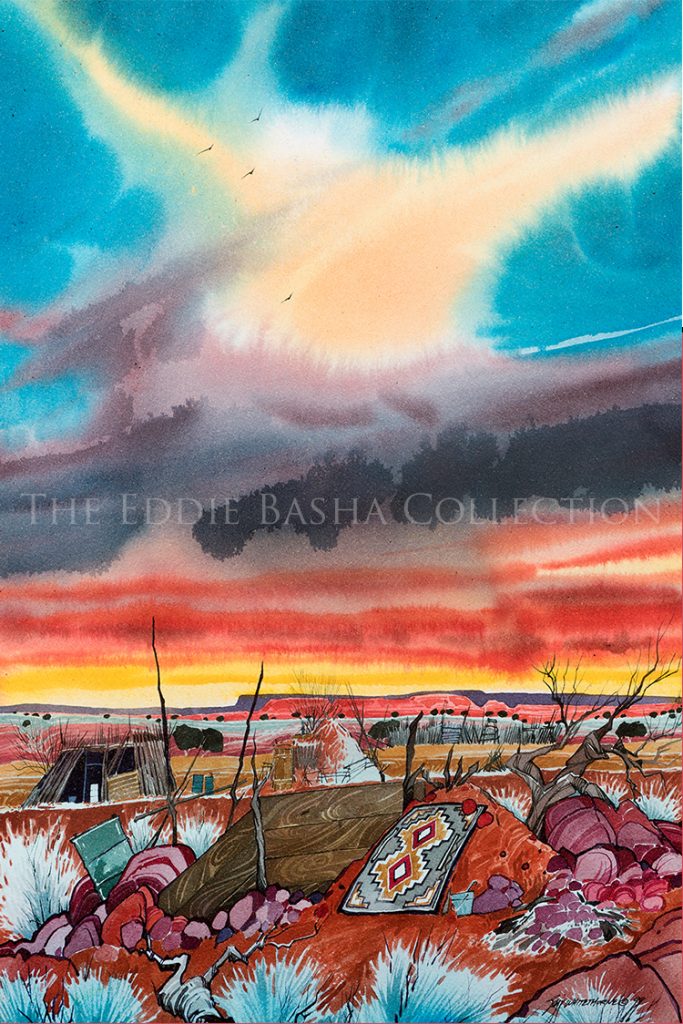 Watercolor (1999) | Image Size: 18”h x 12”w; Framed Size: 28 ¼”h x 21 ¼”
Watercolor (1999) | Image Size: 18”h x 12”w; Framed Size: 28 ¼”h x 21 ¼”“This is a traditional sweat lodge. The doorway is covered with a blanket to seal it and there are boards behind for privacy, blocking out any view within because clothing isn’t worn when inside. A fire is built and the stones gathered next to it are heated and placed inside the lodge. The second stone pile are those that have cooled and been removed from the lodge. The bucket of water next to the lodge is provided so occupants when finished inside can take a drink from the bucket. Grandfathers would spend time with the young boys in the sweat lodge teaching them the lessons and songs that needed to be learned,” shared Baje Whitethorne.
Sweat Lodge
Artist: Baje Whitethorne, Sr. (1951-2023)
“This is a traditional sweat lodge. The doorway is covered with a blanket to seal it and there are boards behind for privacy, blocking out any view within because clothing isn’t worn when inside. A fire is built and the stones gathered next to it are heated and placed inside the lodge. The second stone pile are those that have cooled and been removed from the lodge. The bucket of water next to the lodge is provided so occupants when finished inside can take a drink from the bucket. Grandfathers would spend time with the young boys in the sweat lodge teaching them the lessons and songs that needed to be learned,” shared Baje Whitethorne.
 Watercolor (1994) | Image Size: 10”h x 14”w; Framed Size: 19 ½”h x 23 ½”w
Watercolor (1994) | Image Size: 10”h x 14”w; Framed Size: 19 ½”h x 23 ½”wBaje Whitethorne Sr. grew up on the Navajo Reservation near Shonto, Arizona. As a child, Baje and his siblings would make up stories on their way to visit their grandparents. That storytelling trait continues in Whitethorne’s art which is a reflection of his rich Diné (Navajo) culture and striking landscapes of the West.
“When I was a boy, my parents and grandparents brought home a new card table with six metallic blue chairs. In the summer months, I would put my face against the cool seat of the chairs. Now, I include the chair in my artwork because it reminds me of my boyhood and because it draws people into the work when they try to find it,” shared Baje.
Baje has illustrated numerous children’s books, two of which he also authored “Sunpainters” and “Father’s Boots.” Baje has received a number of honors for his work including the Western Heritage Wrangler Award from the National Cowboy and Western Heritage Museum in Oklahoma City. His work can be found in numerous collections and museums worldwide.
Red Canyon Pass
Artist: Baje Whitethorne, Sr. (1951-2023)
Baje Whitethorne Sr. grew up on the Navajo Reservation near Shonto, Arizona. As a child, Baje and his siblings would make up stories on their way to visit their grandparents. That storytelling trait continues in Whitethorne’s art which is a reflection of his rich Diné (Navajo) culture and striking landscapes of the West.
“When I was a boy, my parents and grandparents brought home a new card table with six metallic blue chairs. In the summer months, I would put my face against the cool seat of the chairs. Now, I include the chair in my artwork because it reminds me of my boyhood and because it draws people into the work when they try to find it,” shared Baje.
Baje has illustrated numerous children’s books, two of which he also authored “Sunpainters” and “Father’s Boots.” Baje has received a number of honors for his work including the Western Heritage Wrangler Award from the National Cowboy and Western Heritage Museum in Oklahoma City. His work can be found in numerous collections and museums worldwide.
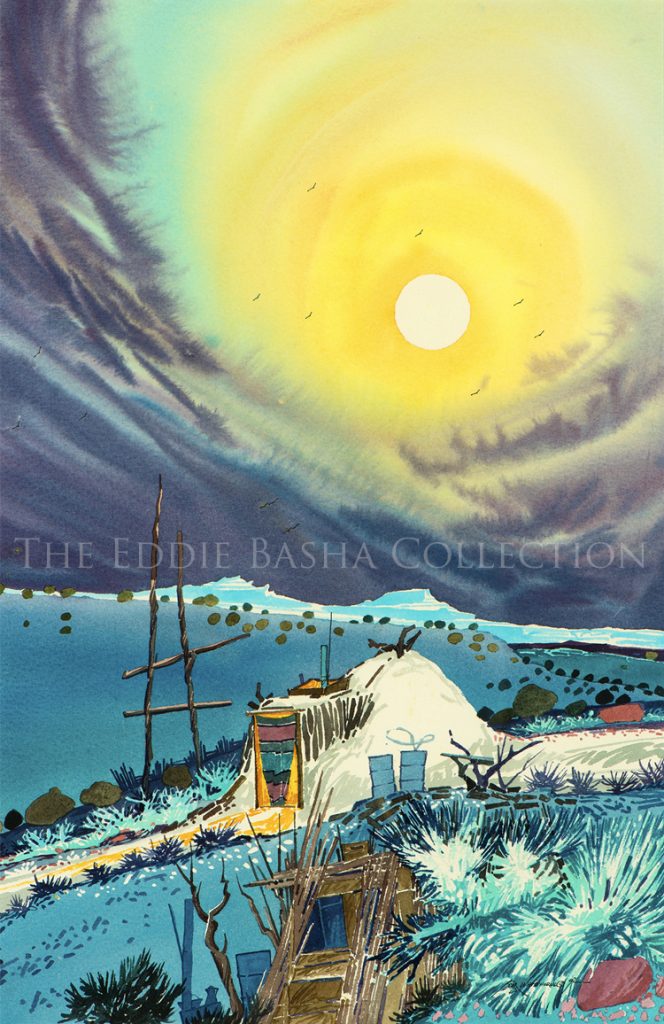 Watercolor (1992) | Image Size: 22”h x 14”w; Framed Size: 33 ½”h X 25 ½”w
Watercolor (1992) | Image Size: 22”h x 14”w; Framed Size: 33 ½”h X 25 ½”wWhitethorne Sr, Baje grew up on the Navajo Reservation near Shonto, Arizona. As a child, Baje and his brothers would make up stories on their way to visit their grandmother. That storytelling trait continues in Whitethorne’s art which is a reflection of his rich culture and striking landscapes as seen here in “Seasons of the Cold Moon”.
Baje has illustrated eight children’s books, two of which he also authored. Among them are stories surrounding the Native American legends of Monster Bird, Monster Slayer, and Sika and the Raven. Baje has received a number of honors for his work including the Western Heritage Wrangler Award from the National Cowboy and Western Heritage Museum in Oklahoma City.
In addition, Baje encourages and shares his knowledge and skills with youth across Arizona and frequently at the Art of the People Fine Art Exhibitions sponsored by the Navajo Nation Shopping Centers, Inc. Navajo Nation Museum Native American Heritage Month Flagstaff, Arizona
Seasons of the Cold Moon
Artist: Baje Whitethorne, Sr. (1951-2023)
Whitethorne Sr, Baje grew up on the Navajo Reservation near Shonto, Arizona. As a child, Baje and his brothers would make up stories on their way to visit their grandmother. That storytelling trait continues in Whitethorne’s art which is a reflection of his rich culture and striking landscapes as seen here in “Seasons of the Cold Moon”.
Baje has illustrated eight children’s books, two of which he also authored. Among them are stories surrounding the Native American legends of Monster Bird, Monster Slayer, and Sika and the Raven. Baje has received a number of honors for his work including the Western Heritage Wrangler Award from the National Cowboy and Western Heritage Museum in Oklahoma City.
In addition, Baje encourages and shares his knowledge and skills with youth across Arizona and frequently at the Art of the People Fine Art Exhibitions sponsored by the Navajo Nation Shopping Centers, Inc. Navajo Nation Museum Native American Heritage Month Flagstaff, Arizona
 Baje Whitethorne (b.1951) and Jim Jackson (b.1963)
Baje Whitethorne (b.1951) and Jim Jackson (b.1963)Bronze | Bronze 24”h x 14”w x 11”d; Edition #3 of 40
Collaboratively, Navajo artist Baje Whitethorne Sr and Modoc artist Jim Jackson sculpted “Souls of the Canyons”. It was one of Baje’s early ventures as a sculptor and he was excited to do so alongside his friend and sculpting mentor. Five Yéi, Navajo Holy People who mediate between the Great Spirit and humans, also provide healing powers and protection. Yei are often depicted in sand paintings and in weavings. And, approximately mid-sculpture, a pueblo is seen in the canyon walls.
Souls of the Canyons
Artist: Baje Whitethorne, Sr. (1951-2023)
Bronze | Bronze 24”h x 14”w x 11”d; Edition #3 of 40
Collaboratively, Navajo artist Baje Whitethorne Sr and Modoc artist Jim Jackson sculpted “Souls of the Canyons”. It was one of Baje’s early ventures as a sculptor and he was excited to do so alongside his friend and sculpting mentor. Five Yéi, Navajo Holy People who mediate between the Great Spirit and humans, also provide healing powers and protection. Yei are often depicted in sand paintings and in weavings. And, approximately mid-sculpture, a pueblo is seen in the canyon walls.
 Bronze (2004) | Image Size: 21”h x 11”w x 11”d; Edition #4 of 30
Bronze (2004) | Image Size: 21”h x 11”w x 11”d; Edition #4 of 30Edgewater Fan Dancer
Artist: Baje Whitethorne, Sr. (1951-2023)
 Watercolor (1994) | Image Size: 7 ½”h x 11”w; Framed: 18 ¼”h x 22 ½”w
Watercolor (1994) | Image Size: 7 ½”h x 11”w; Framed: 18 ¼”h x 22 ½”wuntitled
Artist: Baje Whitethorne, Sr. (1951-2023)
 (1951) | Image Size: 9”h x 13”w
(1951) | Image Size: 9”h x 13”wTake A Closer Look – Water Drum & Chair
Artist: Baje Whitethorne, Sr. (1951-2023)
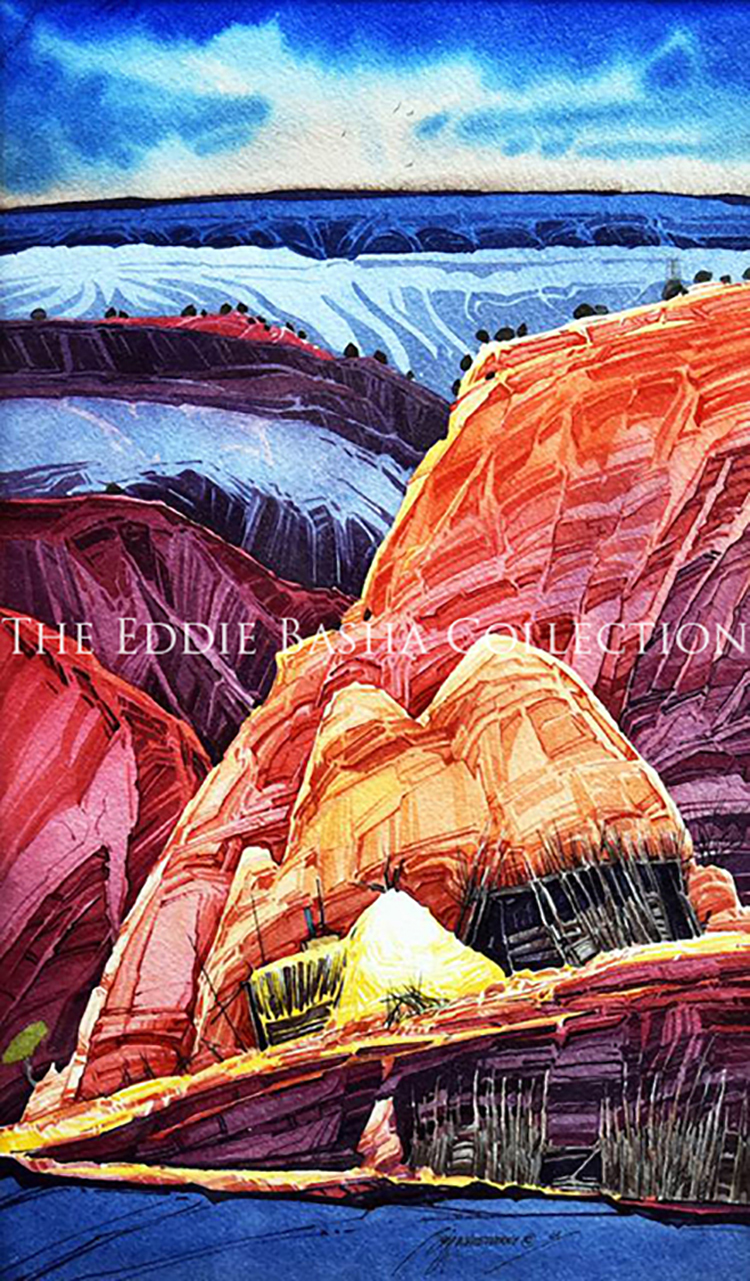 Watercolor (2001) | Image Size: 18”h x 12”w; Framed Size: 24”h x 18”w
Watercolor (2001) | Image Size: 18”h x 12”w; Framed Size: 24”h x 18”wA Morning
Artist: Baje Whitethorne, Sr. (1951-2023)
 Watercolor (2007) | Image Size: 7”h x 5”w; Framed Size: 17 ¼”h x 14 ¼”w
Watercolor (2007) | Image Size: 7”h x 5”w; Framed Size: 17 ¼”h x 14 ¼”wBaje Whitethorne’s “Fancy Pants” is but one of the Yei Be Chei dancers that performs during Navajo ceremonials. The dancers are the embodiment of the Yei Spirit who is the mediator between humans and the Great Spirit. There are over 50 types of ceremonials within the Navajo culture which occur at different times but for very detailed reasons. Ceremonies vary in length and occur at different times during the day or night; some only last for a few hours while others are nine days long.
As a child, Whitethorne and his brothers would make up stories on their way to visit their grandparents. That storytelling trait is a mainstay in his art which is a reflection of his treasured Navajo culture and often includes striking landscapes. Baje has illustrated richly and vibrantly several children’s books and authored a few as well. He has received numerous honors for his work throughout his career.
Fancy Pants
Artist: Baje Whitethorne, Sr. (1951-2023)
Baje Whitethorne’s “Fancy Pants” is but one of the Yei Be Chei dancers that performs during Navajo ceremonials. The dancers are the embodiment of the Yei Spirit who is the mediator between humans and the Great Spirit. There are over 50 types of ceremonials within the Navajo culture which occur at different times but for very detailed reasons. Ceremonies vary in length and occur at different times during the day or night; some only last for a few hours while others are nine days long.
As a child, Whitethorne and his brothers would make up stories on their way to visit their grandparents. That storytelling trait is a mainstay in his art which is a reflection of his treasured Navajo culture and often includes striking landscapes. Baje has illustrated richly and vibrantly several children’s books and authored a few as well. He has received numerous honors for his work throughout his career.